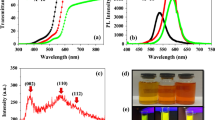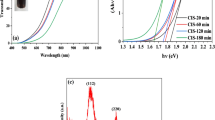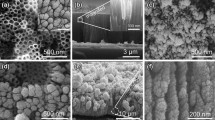Abstract
In this research, quantum dot–sensitized solar cells (QDSCs) were created by employing a co-sensitization approach on a new photoelectrode comprising multiple layers with a cascaded energy-gap structure. The new multilayer photoelectrode consisted of double-layer scaffolds, and a bottom layer of TiO2 nanocrystals (NCs) coated with as-synthesized TiO2 hollow layers (HSs) was utilized in QDSCs. Herein, we offer an eco-friendly, facile, and ultrafast aqueous method to the preparation of CuInS2 (CIS) quantum dots (QDs) as the sensitizer for QDSCs with TiO2 NPs/TiO2 HSs/CIS/CdS/CdSe/ZnS photoelectrode. The production of CIS NCs took place in an aqueous solution through a facile modified chemical precipitation method, followed by their deposition using a drop-casting process. Additionally, the formation of the CdSe layer was achieved employing a chemical bath deposition (CBD) technique. The time of CBD was varied in a short range of 3–10 min for the CdSe QD layer. The outcomes illustrated a considerable efficiency of 5.17% for the QDSC with TiO2 NCs/CIS/CdS/CdSe/ZnS photoanode while the CdSe QDs were deposited at 5 min of the CBD process. The other improved TiO2 NCs/TiO2 HSs/CIS/CdS/CdSe/ZnS photoanode demonstrated a short circuit current density (JSC) of 24.18 mA/cm2, an open circuit voltage (VOC) of 621 mV, a fill factor (FF) of 0.40, and a power conversion efficiency (PCE) of 5.86%. This PCE was improved about 106% compared to those of the reference cell with TiO2 NPs/CIS/ZnS photoanode structure.
Graphical Abstract
Schematic of the CuInS2/CdS/CdSe QD–sensitized solar cell (a) and corresponding flat band energy diagram (b) and J-V characteristics of the reference and co-sensitized devices (c).










Similar content being viewed by others
References
N. Balis et al., Quantum dot sensitized solar cells based on an optimized combination of ZnS, CdS and CdSe with CoS and CuS counter electrodes. Electrochim. Acta 91, 246–252 (2013)
M.P. Dare-Edwards et al., Sensitisation of semiconducting electrodes with ruthenium-based dyes. Faraday Discuss. Chem. Soc. 70, 285–298 (1980)
B. O’regan, M. Grätzel, A low-cost, high-efficiency solar cell based on dye-sensitized colloidal TiO2 films. Nature 353(6346), 737–740 (1991)
P.P. Boix et al., Hole transport and recombination in all-solid Sb2S3-sensitized TiO2 solar cells using CuSCN as hole transporter. J Phys Chem C 116(1), 1579–1587 (2012)
M.P. Genovese, I.V. Lightcap, P.V. Kamat, Sun-believable solar paint. A transformative one-step approach for designing nanocrystalline solar cells. ACS Nano 6(1), 865–872 (2012)
S. Rühle, M. Shalom, A. Zaban, Quantum-dot-sensitized solar cells. ChemPhysChem 11(11), 2290–2304 (2010)
A.J. Nozik, Nanoscience and nanostructures for photovoltaics and solar fuels. Nano Lett. 10(8), 2735–2741 (2010)
J.B. Sambur, T. Novet, B. Parkinson, Multiple exciton collection in a sensitized photovoltaic system. Science 330(6000), 63–66 (2010)
T. Takagahara, K. Takeda, Theory of the quantum confinement effect on excitons in quantum dots of indirect-gap materials. Phys. Rev. B 46(23), 15578 (1992)
Y.-J. Shen, Y.-L. Lee, Assembly of CdS quantum dots onto mesoscopic TiO2 films for quantum dot-sensitized solar cell applications. Nanotechnology 19(4), 045602 (2008)
H.-J. Lee et al., Anchoring cadmium chalcogenide quantum dots (QDs) onto stable oxide semiconductors for QD sensitized solar cells. Bull. Korean Chem. Soc. 28(6), 953–958 (2007)
H.J. Lee et al., CdSe quantum dot-sensitized solar cells exceeding efficiency 1% at full-sun intensity. J Phys Chem C 112(30), 11600–11608 (2008)
W. Lee et al., Co-sensitization of vertically aligned TiO2 nanotubes with two different sizes of CdSe quantum dots for broad spectrum. Electrochem. Commun. 10(10), 1579–1582 (2008)
X. Zhao et al., Fabrication of POSS-coated CdTe quantum dots sensitized solar cells with enhanced photovoltaic properties. J. Alloy. Compd. 726, 593–600 (2017)
H. Seo et al., Analysis on the effect of polysulfide electrolyte composition for higher performance of Si quantum dot-sensitized solar cells. Electrochim. Acta 95, 43–47 (2013)
M.A. Abbas et al., Enhanced performance of PbS-sensitized solar cells via controlled successive ionic-layer adsorption and reaction. Phys. Chem. Chem. Phys. 17(15), 9752–9760 (2015)
A.S. Hassanien, A.A. Akl, Effect of Se addition on optical and electrical properties of chalcogenide CdSSe thin films. Superlattices Microstruct. 89, 153–169 (2016)
N.S.M. Mustakim et al., Quantum dots processed by SILAR for solar cell applications. Sol. Energy 163, 256–270 (2018)
H. Tung, Quantum dots solar cells based On CdS TiO2 photoanode. Int. J. Latest Res. Sci. Technol 3, 15–18 (2014)
J.-K. Sun et al., Three-dimensional nanostructured electrodes for efficient quantum-dot-sensitized solar cells. Nano Energy 32, 130–156 (2017)
F. Ji et al., Oriented rutile TiO2 nanorod arrays for efficient quantum dot-sensitized solar cells with extremely high open-circuit voltage. Ceram. Int. 42(10), 12194–12201 (2016)
T. Shu et al., Mesoscopic nitrogen-doped TiO2 spheres for quantum dot-sensitized solar cells. Electrochim. Acta 68, 166–171 (2012)
J.H. Bang, P.V. Kamat, Quantum dot sensitized solar cells. A tale of two semiconductor nanocrystals: CdSe and CdTe. ACS Nano 3(6), 1467–1476 (2009)
H. Wang et al., In situ versus ex situ assembly of aqueous-based thioacid capped CdSe nanocrystals within mesoporous TiO2 films for quantum dot sensitized solar cells. J Phys Chem C 116(1), 484–489 (2012)
H.J. Lee et al., Regenerative PbS and CdS quantum dot sensitized solar cells with a cobalt complex as hole mediator. Langmuir 25(13), 7602–7608 (2009)
R. Laghumavarapu et al., Improved device performance of In As∕ Ga As quantum dot solar cells with GaP strain compensation layers. Appl. Phys. Lett. 91(24), 243115 (2007)
A.M. Smith, S. Nie, Semiconductor nanocrystals: structure, properties, and band gap engineering. Acc. Chem. Res. 43(2), 190–200 (2010)
M.D. Regulacio, M.-Y. Han, Composition-tunable alloyed semiconductor nanocrystals. Acc. Chem. Res. 43(5), 621–630 (2010)
X. Peng, Band gap and composition engineering on a nanocrystal (BCEN) in solution. Acc. Chem. Res. 43(11), 1387–1395 (2010)
C. Cai et al., Tailoring defects of CuInS2 quantum dots for sensitized solar cells. J. Alloy. Compd. 719, 227–235 (2017)
X. Zhong et al., Composition-tunable Zn x Cd1-x Se nanocrystals with high luminescence and stability. J. Am. Chem. Soc. 125(28), 8589–8594 (2003)
X. Zhong et al., Alloyed Zn x Cd1-x S nanocrystals with highly narrow luminescence spectral width. J. Am. Chem. Soc. 125(44), 13559–13563 (2003)
J. Zhou et al., Preparation of CuInS2 microspheres via a facile solution–chemical method. Mater. Lett. 65(12), 2001–2003 (2011)
Z. Wang et al., Facile synthesis of Cu–In–S/ZnS core/shell quantum dots in 1-dodecanethiol for efficient light-emitting diodes with an external quantum efficiency of 7.8%. Chem Mater 30(24), 8939–8947 (2018)
P.-H. Chuang, C.C. Lin, R.-S. Liu, Emission-tunable CuInS2/ZnS quantum dots: structure, optical properties, and application in white light-emitting diodes with high color rendering index. ACS Appl. Mater. Interfaces. 6(17), 15379–15387 (2014)
D.H. Jara et al., Size-dependent photovoltaic performance of CuInS2 quantum dot-sensitized solar cells. Chem. Mater. 26(24), 7221–7228 (2014)
P.K. Santra et al., CuInS2-sensitized quantum dot solar cell. Electrophoretic deposition, excited-state dynamics, and photovoltaic performance. J Phys Chem Lett 4(5), 722–729 (2013)
Z. Peng et al., Long wavelength optical absorption and photovoltaic performance enhancement on CuInS2 and PbS quantum dot co-sensitized solar cells. J. Alloy. Compd. 701, 131–137 (2017)
Y. Ma et al., Improving the performance of quantum dot sensitized solar cells by employing Zn doped CuInS 2 quantum dots. Adv Compos Hybrid Mater 5, 402–409 (2022)
F. Gao et al., Performance enhancement of perovskite solar cells by employing TiO2 nanorod arrays decorated with CuInS2 quantum dots. J. Colloid Interface Sci. 513, 693–699 (2018)
P. Ilaiyaraja et al., CuInS2 quantum dot sensitized solar cells with high VOC≈ 0.9 V achieved using microsphere-nanoparticulate TiO2 composite photoanode. Solar Energy Mater Solar Cells 178, 208–222 (2018)
M. Sotodeian, M. Marandi, Fabrication of quantum dot-sensitized solar cells with multilayer TiO 2/PbS (X)/CdS/CdSe/ZnS/SiO 2 photoanode and optimization of the PbS nanocrystalline layer. J. Mater. Sci.: Mater. Electron. 32, 10123–10139 (2021)
A.M. Holi et al., PbS/CdS/ZnO nanowire arrays: Synthesis, structural, optical, electrical, and photoelectrochemical properties. Chem. Phys. Lett. 750, 137486 (2020)
U. Bangi, Impact of cadmium salt concentration on CdS nanoparticles synthesized by chemical precipitation method. Chalcogenide Lett 17(11), 537–547 (2020)
K. Jung et al., Effect of manganese dopants on defects, nano-strain, and photovoltaic performance of Mn–CdS/CdSe nanocomposite-sensitized ZnO nanowire solar cells. Compos. Sci. Technol. 179, 79–87 (2019)
M. Marandi, N. Torabi, F.A. Farahani, Facile fabrication of well-performing CdS/CdSe quantum dot sensitized solar cells through a fast and effective formation of the CdSe nanocrystalline layer. Sol. Energy 207, 32–39 (2020)
M. Marandi, M. Nazari, Application of TiO2 hollow spheres and ZnS/SiO2 double-passivaiting layers in the photoanode of the CdS/CdSe QDs sensitized solar cells for the efficiency enhancement. Sol. Energy 216, 48–60 (2021)
T. Kamal et al., Chemical bath deposition of CdS layer for thin film solar cell. Asian J. Res. Eng. Sci. Technol 4, 605–612 (2019)
J.-Y. Chang et al., Toward the facile and ecofriendly fabrication of quantum dot-sensitized solar cells via thiol coadsorbent assistance. ACS Appl. Mater. Interfaces. 8(29), 18878–18890 (2016)
Y.-H. Chiang et al., Aqueous solution-processed off-stoichiometric Cu–In–S QDs and their application in quantum dot-sensitized solar cells. J Mater Chem A 6(20), 9629–9641 (2018)
A. Rasal et al., Efficient quantum-dot-sensitized solar cells with improved stability using thixotropic polymer/nanoparticles-based gel electrolyte. Mater Today Energy 19, 100615 (2021)
C.I. Santos et al., Hydrothermal synthesis of aqueous-soluble copper indium sulfide nanocrystals and their use in quantum dot sensitized solar cells. Nanomaterials 10(7), 1252 (2020)
S. Higashimoto et al., Copper-indium-sulfide colloids on quantum dot sensitized TiO2 solar cell: effects of capping with mercapto-acid linker molecules. J. Colloid Interface Sci. 535, 176–181 (2019)
J. Luo et al., Highly efficient core–shell CuInS 2–Mn doped CdS quantum dot sensitized solar cells. Chem. Commun. 49(37), 3881–3883 (2013)
J.-Y. Chang et al., Improved performance of CuInS2 quantum dot-sensitized solar cells based on a multilayered architecture. ACS Appl. Mater. Interfaces. 5(17), 8740–8752 (2013)
Z. Liang et al., Engineering the synthesized colloidal CuInS 2 passivation layer in interface modification for CdS/CdSe quantum dot solar cells. Dalton Trans. 51(45), 17292–17300 (2022)
M.N.S. Sabet, M. Marandi, F. Ahmadloo, Fabrication of dye sensitized solar cells with different photoanode compositions using hydrothermally grown and P25 TiO2 nanocrystals. Eur Phys J Appl Phys 69(2), 20401 (2015)
M. Marandi, F.A. Farahani, M. Davoudi, Fabrication of submicron/micron size cavities included TiO2 photoelectrodes and optimization of light scattering to improve the photovoltaic performance of CdS quantum dot sensitized solar cells. J. Electroanal. Chem. 799, 167–174 (2017)
M. Sotodeian, M. Marandi, Effects of PbS quantum dots layer and different light scattering films on the photovoltaic performance of double passivated PbS, CdS and CdSe quantum dots sensitized solar cells. Sol. Energy 221, 418–432 (2021)
Y. Feng et al., Can Tauc plot extrapolation be used for direct-band-gap semiconductor nanocrystals? J. Appl. Phys. 117(12) (2015)
A. Bradley, A. Jay, A method for deducing accurate values of the lattice spacing from X-ray powder photographs taken by the Debye-Scherrer method. Proc Phys Soc 44(5), 563 (1932)
A. Raevskaya et al., Non-stoichiometric Cu–In–S@ ZnS nanoparticles produced in aqueous solutions as light harvesters for liquid-junction photoelectrochemical solar cells. RSC Adv. 6(102), 100145–100157 (2016)
L. Zhang et al., Copper deficient Zn–Cu–In–Se quantum dot sensitized solar cells for high efficiency. J Mater Chem A 5(40), 21442–21451 (2017)
A.S. Fuhr et al., Light emission mechanisms in CuInS2 quantum dots evaluated by spectral electrochemistry. ACS Photonics 4(10), 2425–2435 (2017)
B. Chen et al., Highly emissive and color-tunable CuInS2-based colloidal semiconductor nanocrystals: off-stoichiometry effects and improved electroluminescence performance. Adv. Func. Mater. 22(10), 2081–2088 (2012)
T.-L. Li, Y.-L. Lee, H. Teng, CuInS2 quantum dots coated with CdS as high-performance sensitizers for TiO2 electrodes in photoelectrochemical cells. J. Mater. Chem. 21(13), 5089–5098 (2011)
J. Halme et al., Spectral characteristics of light harvesting, electron injection, and steady-state charge collection in pressed TiO2 dye solar cells. J Phys Chem C 112(14), 5623–5637 (2008)
A. Fillinger, B. Parkinson, The adsorption behavior of a ruthenium-based sensitizing dye to nanocrystalline TiO2 coverage effects on the external and internal sensitization quantum yields. J. Electrochem. Soc. 146(12), 4559 (1999)
Author information
Authors and Affiliations
Corresponding author
Ethics declarations
Conflict of interest
The authors declare no competing interests.
Rights and permissions
Springer Nature or its licensor (e.g. a society or other partner) holds exclusive rights to this article under a publishing agreement with the author(s) or other rightsholder(s); author self-archiving of the accepted manuscript version of this article is solely governed by the terms of such publishing agreement and applicable law.
About this article
Cite this article
Karkhaneh, A., Marandi, M. Facile fabrication of quantum dot–sensitized solar cells with multilayer TiO2 NCs/TiO2 HSs/CIS/CdS/CdSe(Xmin)/ZnS photoanode and modification of light scattering and co-sensitization for higher efficiencies. emergent mater. (2024). https://doi.org/10.1007/s42247-024-00705-1
Received:
Accepted:
Published:
DOI: https://doi.org/10.1007/s42247-024-00705-1




